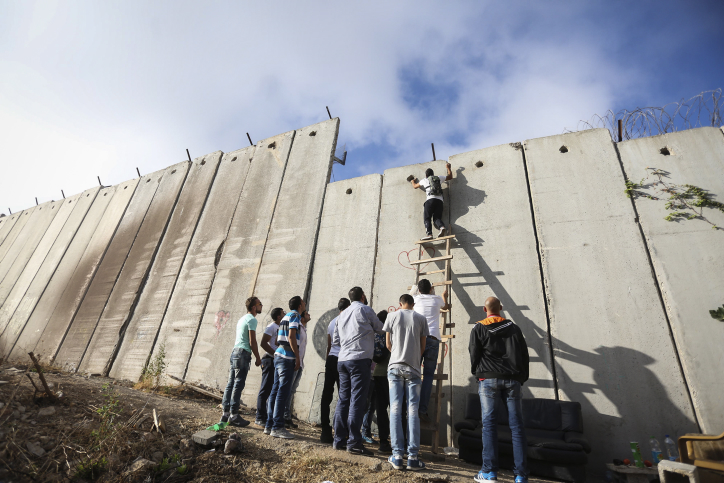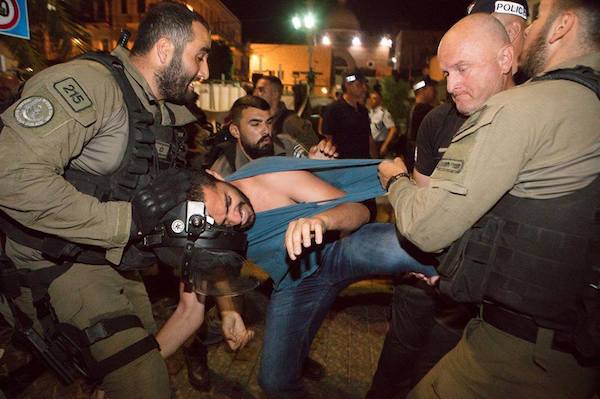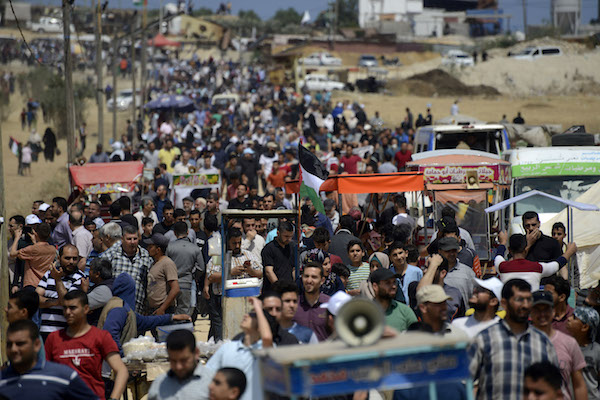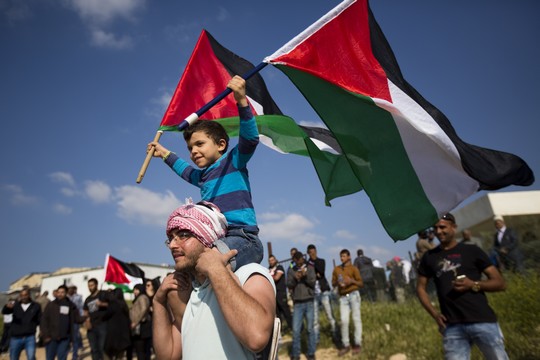Despite physical separation and internal divisions, Palestinians on both sides of the Green Line are once again talking about the future of their struggle, and the role that Palestinian citizens of Israel can play.

Out of sight from most of the Israeli public, yet under the close watch of the government, an internal debate has been raging within Palestinian society about the devastating effects of the physical separation and internal divisions plaguing Palestinians.
Two recent protests, one in Haifa in solidarity with Gaza and another in Ramallah against the Palestinian Authority’s role in the siege — in which Palestinian citizens of Israel also participated — helped reinvigorated the conversation about the relationship between Palestinians on both sides of the separation wall and the role of Palestinian citizens of Israel in the struggle against the occupation.
Dr. Huneida Ghanem, who runs Madar — The Palestinian Center for Israeli Studies, has been studying this issue for years. In her research, Ghanem, who divides her time between Israel and Ramallah, has found that despite the divisions, most Palestinians agree on several main points: the division between them was forced on them, that it weakens them, and that it allows Israel to more easily control them.

The divisions do not begin and end with the wall and the occupation. For years, Fatah and Hamas have been unable to reconcile, despite the pleas of their people. Palestinians inside Israel face divisions of their own, including along religious lines, political disputes, and geographic differences that beget cultural gaps.
All these factors have, over the years, created distinct political, social and economic situations for each community, which has led to different needs and problems that require different approaches and policies. As a result, according to Ghanem, each group has developed its own political program to deal with the occupation.
In the occupied territories, the struggle focuses on establishing a state through both violent and nonviolent means, including popular struggle and the BDS movement. Those in the West Bank focus on settlements and apartheid; in Gaza the focus is on the hardships created by the siege, as well as the violence and destruction wrought by wars with Israel every few years and the rebuilding between the violence.
Palestinian citizens of Israel are fighting for equal citizenship through political parties and extra-parliamentary organizations, focusing mostly on discrimination and racist laws. And outside of Palestine, millions of refugees are struggling for the right to return to their land.

According to Ghanem, the two intifadas were transformative for Palestinians on both sides of the Green Line. During the First Intifada, during which hundreds of thousands of Palestinians in the occupied territories protested against the occupation, Palestinians inside Israel held nonviolent demonstrations in solidarity, while demanding equality for all Israeli citizens. The Second Intifada, however, was a turning point: entire Palestinian communities were affected regardless of their geographical location, and Palestinians suddenly felt then that Jaffa’s fate was linked to that of Jerusalem and Jenin.
Arabs or Palestinians?
Despite the physical disconnect and the various divisions, more and more Arabs in Israel are defining themselves as Palestinian. The more Israel insists on using the term “Israeli Arabs” and tries to force an identity upon them, the more pride they show in their national identity. Identity, after all, is part of the struggle.

A year and a half ago, I published a series of video reports on Social TV looking at the history of national identity among Arab citizens of Israel, and specifically how Land Day in 1976 and the events of October 2000 were crucial in pushing them to adopt a Palestinian identity.
One of my interviewees, Dr. Marwan Darweish, a lecturer in Peace Studies at Coventry University in the U.K., explained the phenomenon:
The internal Palestinian divisions, the siege, the settlements, the wall — all of them have created a different situation and divisions among the various groups of Palestinian teenagers. I think this is one of the goals of Israeli policy: that people will call themselves Palestinian, but that there will be internal divisions and differences and to a certain degree conflict between them. Creating different images of one another. How Palestinians from Gaza view Palestinians in Jerusalem or inside Israel. This image, and the creation of different identities in a sense serves the state, the occupation, and Israeli control over the Palestinians.
Activist Qamer Taha said at the time: “There are several studies that show that over the last several years between 30 and 40 percent of teenagers have called themselves ‘Palestinians’ without truly understanding the complexity of the situation.” Taha suggested that the younger generation might be adopting Palestinian identity as a response to the ethnic divisions inside Palestinian society in Israel. Instead of Muslims or Christians, there are simply Palestinians.
Chicken and the egg
Despite the sense of and pride in their Palestinian identity, however, fewer and fewer Palestinian citizens have staged protests in recent years, and in some ways, have become far less politically involved.
“There are several reasons why fewer Palestinians are going out into the streets. One of the main ones is a lack of a clear political vision and strategy,” said Muhammad Younis, an activist who lives in Haifa. (No relation to the author.) Younis is one of the founders of a new movement building support for a single, democratic state in Israel-Palestine on the basis of equality between Arabs and Jews.
“Add to that what is happening in Syria and you’ll feel the collective despair and frustration,” Younis continued. “There is also frustration with our leadership — the Joint List and the Higher Arab Monitoring Committee. The latter has completely lost the trust of the public.”
“Recent polls show that Palestinian citizens of Israel are focused on the [inter-communal] violence raging in our streets, and rightly so. We are focusing on our immediate problems, so how can we bring out thousands to protest for Gaza? This poses a strategic dilemma: take care of the violence or continue to oppose the occupation, since [the latter] allows and benefits from the violence? It’s a chicken and egg situation. Which came first, violence or the occupation?”
Younis said he believes that Palestinian citizens of Israel are distancing themselves from Palestinians in the West Bank, catalyzed by both the events happening Arab world, as well as the cumulative effect of Israeli hasbara. “Palestinians are looking at the Arab Spring and they say, ‘maybe things are actually good in Israel.’ Some of them are beginning to adopt the deceitful Zionist arguments against the Joint List, that it does nothing to tackle the problems of Arab society inside Israel. This, of course, is happening because of the unbearable violence. A large part of our public is beginning to make a distinction between the occupation and our societal issues, without understanding how the occupation benefits from the latter.”

A year and a half ago, I sat in Dr. Ghanem’s office in Ramallah, right as the PA began putting sanctions against the residents of Gaza by stopping to pay for their electricity. “People are terrified,” Ghanem said, explaining why almost nobody was taking to the streets. “It’s not that they like [the PA policies], or that they aren’t hurting. They are hurting and frustrated, yet they do not protest because they see what is happening in Syria. In a way, the lack of opposition to Abbas is akin to accepting the lesser evil.”
Perhaps things are changing anyway. In the past few months there have been high-profile demonstrations in Haifa (despite the relatively low turnout) and Ramallah (despite the fear of protesting the PA). Is it possible that the demonstrators in Ramallah were inspired by those in Haifa and the recent anti-government protests in Jordan? Is the fact that activists from Haifa joined the demonstrations in Ramallah a harbinger of cooperation on both sides of the wall? Could it be that in Ramallah the fears of the Arab Spring are beginning to fade? Time will tell.
This article was first published in Hebrew on Local Call. Read it here.

